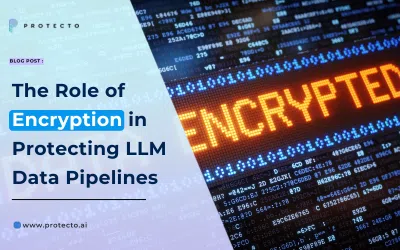Understanding LLM Encryption and Its Importance
Encryption is a fundamental process in cybersecurity that protects data from unauthorized access by converting it into a coded format. Over the years, encryption has evolved from basic ciphers to advanced techniques such as AES (Advanced Encryption Standard) and RSA (Rivest-Shamir-Adleman). With the increasing reliance on Large Language Models (LLMs) for AI-driven applications, LLM encryption has become essential in securing sensitive data throughout AI data pipelines.
Why Secure Data Pipelines Matter for LLMs
LLMs are widely used in various domains, including chatbots, content generation, and data analysis. These applications require vast amounts of data, making LLM data pipelines a prime target for cyber threats. Without adequate protection, vulnerabilities in LLM pipelines can lead to unauthorized access, data breaches, and privacy violations. Implementing encryption ensures that sensitive data remains protected across all stages—from data collection to deployment and inference.
Ensuring the security of LLM data pipelines is critical to maintaining the trust and reliability of these advanced AI systems.
Understanding LLM Data Pipelines
Key Stages in LLM Data Pipelines
LLMs operate through complex data pipelines comprising several critical stages.
1. Data Collection and Preprocessing
The first stage of an LLM data pipeline involves gathering raw data from multiple sources, including databases, APIs, and data lakes. This data must be cleaned, formatted, and normalized to ensure consistency before training. Implementing AI encryption at this stage prevents exposure of sensitive information during transmission and preprocessing.
2. Model Training and Fine-Tuning
During model training, large datasets are processed to optimize the LLM’s accuracy. Secure training methodologies, such as Federated Learning and Secure Multi-Party Computation (SMPC), ensure that encrypted data remains confidential. Techniques like LLM homomorphic encryption allow computations on encrypted data without the need for decryption, enhancing security in training environments.
3. Deployment and Inference
Once trained, the LLM is deployed into production environments where it processes real-time inputs and generates outputs. Encryption plays a crucial role in ensuring secure data pipelines by safeguarding data at rest and in transit. Secure model serving mechanisms, including encrypted APIs and access controls, enhance data security in inference stages.
Data Flow in LLM Pipelines
The data flow within LLM pipelines begins with input data ingestion, where data is fed into the system from various sources, including databases, APIs, and data lakes. This data is then stored and retrieved during the preprocessing and training stages.
Data storage and retrieval are vital for maintaining the integrity and availability of the data throughout the pipeline. Secure and efficient storage solutions are essential to govern the vast amounts of data involved in training LLMs.
The final phase, output data generation, and usage, involves the model producing results from the processed inputs. These outputs must be managed securely to protect sensitive information and guarantee compliance with relevant data protection regulations.
Types of Encryption
Symmetric Encryption
Symmetric encryption involves using an identical key for both encryption and decryption. Examples include Advanced Encryption Standard (AES) and Data Encryption Standard (DES). Symmetric encryption is known for its efficiency and swiftness, making it suitable for encrypting large volumes of data. However, its major limitation is key distribution; securely sharing the key between parties can be challenging. If the key is compromised, the entire encrypted data becomes vulnerable. AI data encryption solutions must include secure key management to prevent unauthorized access.
Asymmetric Encryption
Asymmetric encryption, also called public-key cryptography, uses a pair of different keys: a public key for encryption and a private key for decryption. RSA and ECC (Elliptic Curve Cryptography) are commonly used in LLM security to enable encryption-friendly LLM architecture, ensuring secure communication between systems. The primary strength of asymmetric encryption lies in its secure key distribution, as the public key can be openly shared without compromising security. Yet, asymmetric encryption is more computationally intensive and slower than symmetric encryption, making it less perfect for large data sets.
Hybrid Encryption
Hybrid encryption merges the strengths of both symmetric and asymmetric encryption. It uses asymmetric encryption to securely exchange a symmetric key, which is then used for data encryption. This approach leverages the speed of symmetric encryption and the secure key distribution of asymmetric encryption. This method is widely used in TLS/SSL protocols, ensuring that encrypted LLM pipelines can securely exchange keys and encrypt large datasets efficiently. Its flexibility and efficiency make it an optimal choice for protecting LLM data pipelines and balancing security and performance.
Encryption in Different Stages of LLM Data Pipelines

Data Collection and Preprocessing
Encrypting data at the source is crucial in the initial data collection and preprocessing stage. Data integrity and authenticity can be ensured from the moment data is gathered by applying encryption techniques such as AES (Advanced Encryption Standard) or RSA (Rivest-Shamir-Adleman).
This step involves encrypting data, whether collected through user inputs, sensors, or external databases before it leaves its origin point. Secure data preprocessing also means maintaining encryption as data is cleansed, normalized, and transformed for use in model training. Ensuring data integrity involves verifying that the data has not been tampered with during transmission and processing.
Techniques such as LLM data loss prevention (LLM DLP) help in identifying and masking sensitive data before it enters the preprocessing stage.
Model Training and Fine-tuning
Protecting sensitive data becomes a critical concern during model training and fine-tuning. Approaches such as Secure Multi-Party Computation (SMPC) and Federated Learning allow multiple parties to collaborate on training models without sharing raw data. Using Federated Learning and SMPC ensures that multiple parties can collaborate on model training without exposing their raw data. LLM homomorphic encryption allows encrypted computations, reducing the risk of data leakage while preserving model accuracy.
SMPC divides data into encrypted pieces distributed among parties, ensuring no single party can access the entire dataset.
On the other hand, Federated Learning enables model training across decentralized devices, where data remains local and only model updates are shared and aggregated. These methods significantly enhance privacy by minimizing data exposure while maintaining the effectiveness of the training process.
Deployment and Inference
Encrypting data at rest and in transit is paramount in the deployment and inference stages. Data at rest, stored in databases or cloud storage, should be encrypted using robust algorithms like AES-256 to prevent unauthorized access. Similarly, data in transit between servers, APIs, and end-users must be protected using TLS/SSL protocols to ensure secure communication channels. This ensures that sensitive data, such as user inputs or generated outputs, remains confidential and tamper-proof throughout the interaction with the deployed LLM.
Ensuring traceability in LLM pipelines through encryption allows organizations to monitor data access and modifications, strengthening compliance with data security regulations.
Secure model serving involves managing API endpoints securely, implementing robust authentication and authorization mechanisms, and monitoring access patterns to detect and mitigate potential security threats. Encrypting data at every stage—from collection and preprocessing to training, deployment, and inference—significantly reduces the risk of data breaches, confirming the confidentiality and integrity of data handled by LLMs.
Challenges and Limitations of Encryption in LLM Pipelines
Performance Overhead
Implementing encryption in LLM data pipelines can introduce significant performance overhead. Encrypting and decrypting data adds computational complexity, potentially slowing down data processing and model inference. This can lead to inflated latency and reduced throughput, affecting the system’s efficiency. Balancing the need for robust security with the demand for high performance is a critical challenge. Efficient encryption algorithms and optimized hardware can help mitigate these impacts, but a trade-off often remains.
Encryption can introduce computational delays, impacting the speed and efficiency of LLM pipelines. Optimizing encryption methods and leveraging hardware acceleration can help balance security with performance.
Key Management
Effective key management is binding for maintaining the security of encrypted data. This involves the secure generation, storage, and distribution of encryption keys. Poor key management practices can lead to unauthorized access and data breaches. Additionally, handling key rotation and revocation adds another layer of complexity. Managing encryption keys securely is crucial to preventing unauthorized access. Implementing robust LLM data loss prevention measures, such as automated key rotation and secure key storage, mitigates risks associated with compromised keys.
Scalability Issues
Encrypting large volumes of data in LLM pipelines presents scalability challenges. As the amount of data increases, so does the computational burden of encryption and decryption processes. Ensuring consistent performance at scale requires scalable encryption solutions that can handle high data throughput without significant degradation in speed. Furthermore, distributed data environments, often used in LLM training and deployment, require synchronized encryption mechanisms to maintain security across multiple nodes.
Adopting lightweight encryption techniques ensures that LLM encryption remains efficient for large-scale applications.
Advanced Encryption Techniques for LLMs

Homomorphic Encryption
Homomorphic encryption allows computations to be executed on encrypted data without needing to decrypt it first. This is particularly beneficial for protecting sensitive data in LLM training stages without exposing raw information. Applications include secure data analytics and private machine learning. The primary advantages are enhanced security and privacy, but challenges include significant computational overhead and complexity in implementation.
Secure Multi-Party Computation (SMPC)
Secure Multi-Party Computation (SMPC) is a cryptographic protocol that entitles multiple parties to together compute a function over their inputs while holding those inputs private. In the context of LLMs, SMPC enables collaborative model training and inference without exposing underlying data. This technique is handy in critical data privacy and regulatory compliance scenarios. Benefits include secure collaborative learning and reduced risk of data breaches, though it can be complex to manage and resource-intensive. This technique is crucial for enhancing privacy in AI-driven applications.
Zero-Knowledge Proofs
Zero-knowledge proofs (ZKPs) enable one party to prove to another that a statement is true without revealing any information beyond the statement’s validity. For LLMs, ZKPs can enhance privacy and security by allowing verification of computations or data integrity without exposing the actual data. This technique is valuable for secure data sharing and verification processes. While ZKPs offer robust security benefits, they can be computationally intensive and challenging to implement effectively.
This is useful for secure model validation and regulatory compliance in secure data pipelines.
Final Thoughts
To protect LLM pipelines from security threats, organizations must prioritize robust encryption strategies at every stage—from data collection to inference. Advanced encryption techniques, such as LLM homomorphic encryption and SMPC, provide promising solutions for securing AI models without compromising performance.
Protecto helps organizations implement end-to-end LLM encryption strategies, ensuring that AI-driven systems remain secure, compliant, and efficient in handling sensitive data. Investing in AI data encryption today will ensure safer and more resilient AI applications in the future.




